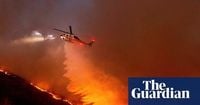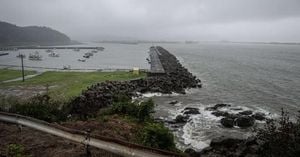In January 2025, the skies over Los Angeles glowed orange for weeks as firefighters waged a relentless battle against more than a dozen wildfires. Among them, the Eaton and Palisades fires stood out not only for their ferocity but for their devastating toll: together, they scorched 38,000 acres, destroyed 16,000 structures, and claimed 31 lives. These two blazes are now ranked as the second- and third-most destructive wildfires in California’s history, according to reporting from UC Merced and Science. Yet, as shocking as these numbers are, experts warn that such catastrophic fires are no longer rare exceptions—they’re fast becoming the global norm.
A comprehensive new study published on October 2, 2025, in the journal Science pulls back the curtain on a disturbing trend. Researchers from the University of California, Merced’s Fire Resilience Center and the University of Tasmania’s Fire Centre analyzed 44 years of wildfire disaster records, tapping into proprietary insurance data from Munich Re and public disaster databases. Their findings are sobering: 43 percent of the world’s 200 most catastrophic wildfires have occurred in just the past decade. Since 1980, economic wildfire disasters have increased more than fourfold, and fatal blazes causing 10 or more deaths have tripled—trends that have only accelerated in recent years.
"The rise in wildfire disasters isn’t just a perception, it’s reality," co-author Professor Crystal Kolden, director of the Fire Resilience Center at UC Merced, told UC Merced News. "For decades, wildfires primarily impacted largely unpopulated areas, but contemporary catastrophic fires are killing more people and destroying more homes and infrastructure." Lead author Professor Calum Cunningham from the University of Tasmania’s Fire Centre put it bluntly: "We’re witnessing a fundamental shift in how wildfires impact society."
The study defined a catastrophic wildfire as one that either killed at least 10 people or ranked among the 200 most economically damaging events worldwide. The researchers found that half of all 43 wildfire disasters causing $1 billion or more in damages since 1980 struck in the last ten years alone. The 2018 fire season marked a particularly grim milestone, with global wildfire losses peaking at $28.3 billion—five times the 44-year average.
Despite massive increases in firefighting investment, the devastation has only grown. In the United States, federal fire suppression spending nearly quadrupled to $4.4 billion by 2021, according to Science. Yet, as the Los Angeles and Lahaina fires demonstrate, disasters continue to escalate. "A majority of global fire disasters occurred with hellacious fire weather that overwhelmed fire suppression efforts," said co-author Professor John Abatzoglou, a climatologist at UC Merced. "Moreover, such extreme fire weather conditions are becoming more likely, increasing the odds of disastrous fires. While we have seen this play out in catastrophic fires in California, the same factors have played out across the globe."
What’s fueling this alarming rise? The study points to a convergence of three factors: intense daily fire activity, the proximity of human populations, and valuable infrastructure in harm’s way. Mediterranean-type forests—like those in southern Europe, California, southern Australia, and Chile—as well as temperate conifer forests in western North America, are especially vulnerable, experiencing disaster rates far out of proportion to their land area.
But the real game-changer, say the researchers, is the weather. Half of all disasters analyzed struck during the most extreme fire-conducive conditions on record—the worst 0.1 percent of days, which typically occur only once every few years. Since 1980, severe fire weather has become more than twice as common, atmospheric dryness has increased 2.4 times, and severe droughts have more than tripled. "We’re dealing with fires under weather conditions fundamentally more dangerous than previous generations experienced," said co-author Professor David Bowman from the University of Tasmania. Cunningham added in The Guardian, "These aren’t just bigger fires, they’re fires occurring under increasingly extreme weather conditions that make them unstoppable."
Climate change, driven by human activity—especially fossil fuel burning—is a central culprit. The study leaves little room for doubt. "It is unambiguous and it is clear climate change is playing a role," Cunningham told The Guardian. As global temperatures rise, so does the frequency of “disaster weather”—the kind of dry, hot, and windy conditions that turn manageable blazes into uncontrollable infernos.
The research team’s model, which assesses risk based on these converging factors, successfully forecasted major disasters that occurred after their study period. The Los Angeles fires in January 2025, which caused an estimated $65 billion in damages—possibly the costliest fire disaster in history—and Chile’s Las Tablas fire in 2024, which killed 135 people, both struck in areas the model identified as extremely high risk. According to Bowman, "This provides a roadmap for where the next catastrophic disasters are most likely to occur. But climate change has fundamentally altered the game. We need to adapt how we live with fire, not just fight it."
Yet the true toll of wildfires extends far beyond the immediate destruction of homes and infrastructure. The 2015 fires in Indonesia, for example, caused $1.2 billion in direct damage, but the World Bank estimated total economic costs at $19.9 billion when factoring in health impacts and lost productivity. Globally, smoke from landscape fires is estimated to kill 1.5 million people each year—a staggering figure that’s largely absent from official disaster databases.
Canada, too, finds itself in the bullseye. Western Canada and the western U.S. are identified as high-risk areas, with recent disasters like the Jasper fire in 2024 and the Los Angeles fires in 2025 both occurring in zones flagged as dangerous by the researchers’ model, according to CBC. Jason Thistlethwaite, a professor at the University of Waterloo, argues that Canada needs to treat wildfire risk as a national priority, akin to major infrastructure projects. "We not only need the resources going towards preparedness but we also need to be ready for response," he said. "We know how to battle wildfires in Canada. We’re excellent at it in fact, but we’re resource starved."
Despite the availability of sophisticated risk data—much of it held privately by insurance companies—public access remains limited. Thistlethwaite points out that without clear information on local risks, it’s difficult to convince people to invest in expensive adaptation measures. "Canadians are adults. We know dollars and cents. When you give that to them, they’ll take the action," he said.
The current 2025 fire season is already running above normal in both Northern and Southern California, with high grass fuel loads and drying conditions raising the risk of large fires across timber and coastal grasslands, according to Cal Fire. The study’s authors stress the urgent need for comprehensive adaptation strategies. These include combining Indigenous fire management techniques with modern approaches, such as fuel reduction, stricter building standards, and robust evacuation planning.
As Professor Abatzoglou noted, "The warming climate further exacerbates the risk of fire disasters already escalated through increased population in or near fire-prone areas and fuel accumulation in adjacent lands." The message from the research is clear: while the world can’t eliminate wildfire risk, it can—and must—learn to live with fire in smarter, safer ways. The stakes have never been higher, and the time for adaptation is now.





